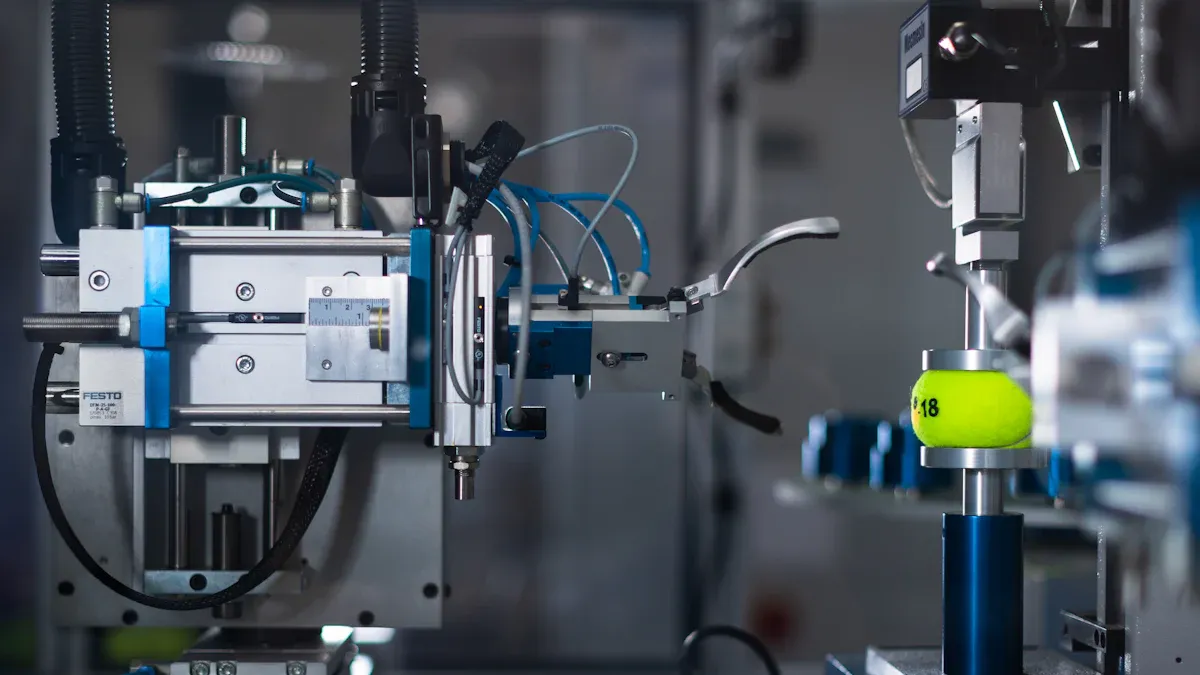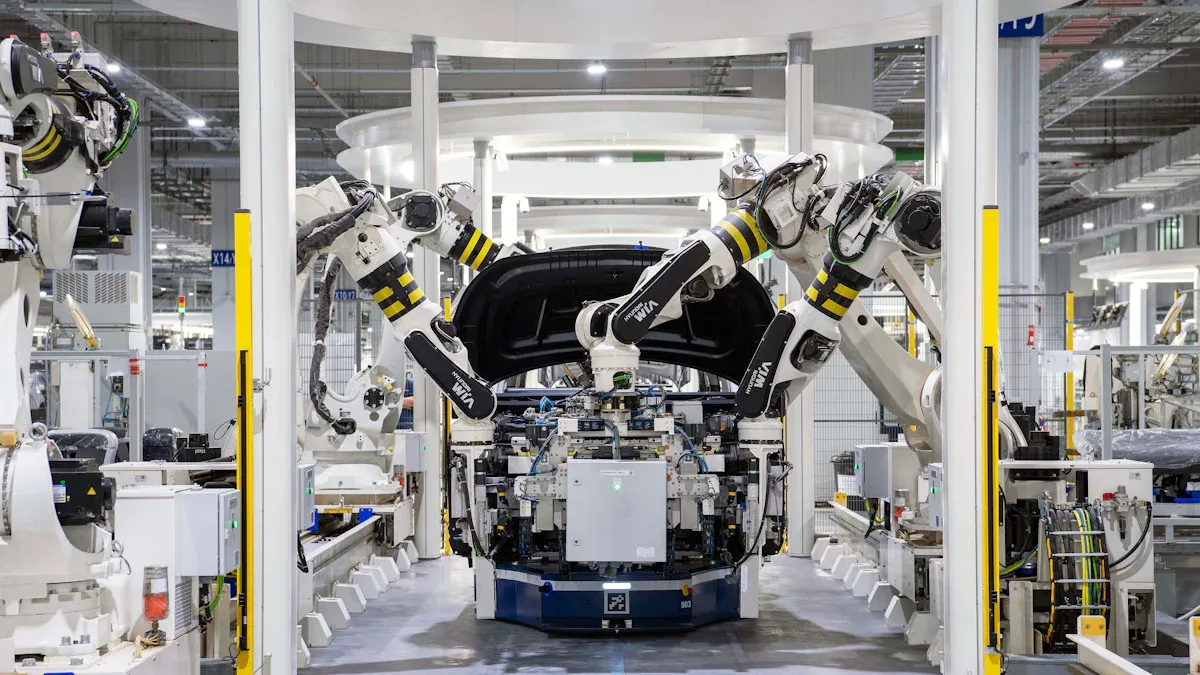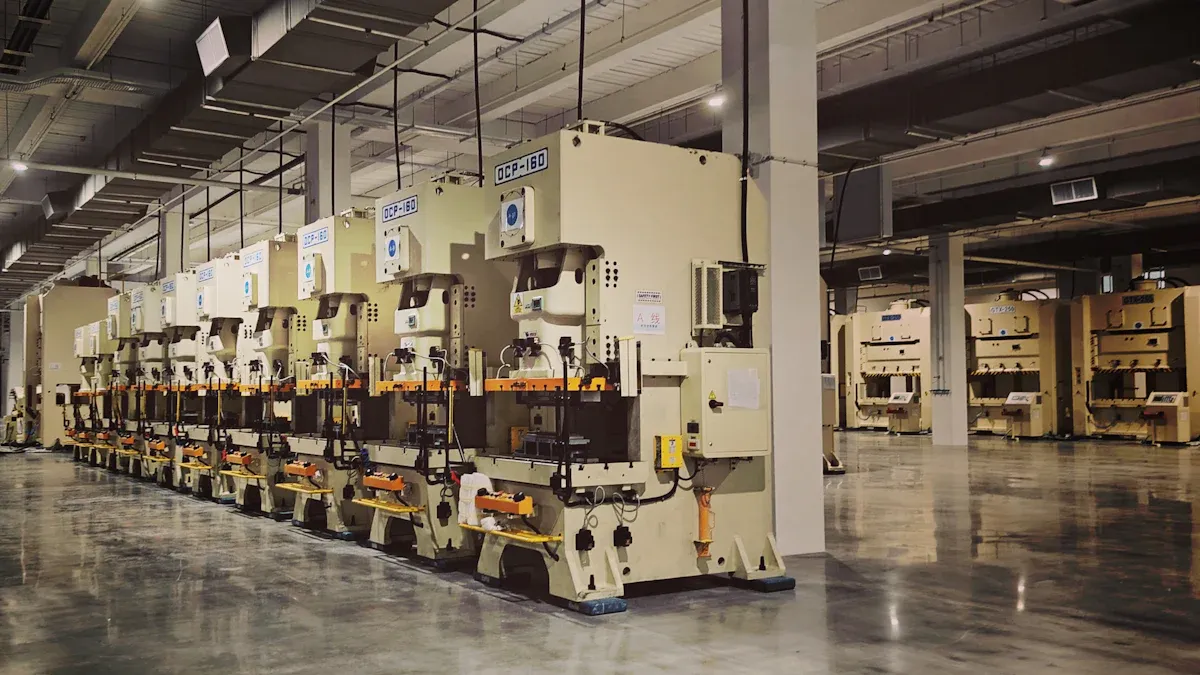
In manufacturing, precision and efficiency determine success. A mold temperature controller ensures consistent mold temperatures, which improves product quality and reduces production flaws. Studies reveal that advanced temperature control systems, such as those utilizing fuzzy logic, can reduce core surface temperature differences by up to 91%. These innovations enhance production, especially for complex molds. Reliable mold temperature controller units also integrate smart sensors and automation, ensuring seamless operation and reduced downtime.
Key Takeaways
- Mold temperature controllers keep temperatures steady, making products better and reducing mistakes.
- Modern systems use up to 75% less energy, cutting costs and helping the environment.
- Picking the right controller depends on size, cost, and system fit to boost work and results.
What Are Mold Temperature Controllers?
Definition and Function
A mold temperature controller is a device designed to regulate the temperature of molds used in manufacturing processes. It ensures that molds maintain a consistent temperature, which is critical for producing high-quality products. These controllers work by circulating a heat transfer medium, such as water or oil, through the mold. The medium absorbs or releases heat to maintain the desired temperature.
Different applications require specific temperature settings. For instance, injection molding cavities typically operate at 100°C with water as the coolant, while oil-based systems for aluminum die casting may reach temperatures between 200°C and 300°C. The table below highlights some common applications and their corresponding temperature settings:
| Application | Temperature Setting (°C) | Coolant Type |
|---|---|---|
| Injection Molding Cavity | 100 | Water |
| Water Temperature Controller | 105-110 | Water |
| Oil Temperature Machine | 130-150 | Oil |
| Aluminum Die Casting | 200-300 | N/A |
| Aluminum Alloy Melting Point | >700 | N/A |
Role in Manufacturing Industries
Mold temperature controllers play a vital role in various industries, including plastic processing, metal die casting, and rubber molding. These devices ensure precise temperature control, which is essential for producing durable and accurate components. In the injection molding industry, temperature control errors account for 20% of product rejects. By improving process consistency, these errors can be significantly reduced.
Advanced systems, such as iQ flow control, further enhance efficiency by continuously adjusting pump speeds during production. This technology reduces energy consumption by up to 85%, leading to CO2 savings of approximately 160 tons annually. Additionally, maintenance costs for temperature control units can decrease by up to 50%.
The increasing complexity of products in industries like automotive, electronics, and medical devices highlights the importance of mold temperature controllers. These devices not only improve product quality but also enhance manufacturing efficiency, making them indispensable in modern production environments.
Key Features of Mold Temperature Controllers

Temperature Accuracy and Stability
Maintaining precise and stable mold temperatures is essential for high-quality production. Mold temperature controllers achieve this by regulating heat transfer mediums like water or oil. Experimental data validates their accuracy. For instance, tests on thin-walled molds made of polyamide 6 + 30% glass fiber demonstrated temperature differences of less than 5°C, even with insert thicknesses of 1.1 mm.
Local mold temperature control further enhances stability, especially for complex designs. High mold temperatures, ranging from 20°C to 80°C, ensure proper cavity filling and reduce defects like warpage. These systems align closely with simulation results, showcasing their reliability in real-world applications.
| Experiment Details | Results | Comparison to Simulation |
|---|---|---|
| Insert Thickness: 1.1 mm | Temperature difference < 5 °C | Excellent accord with simulation |
| Gas Gap: 3.5 mm | Repeated 10 times | Sensor latency accounted for discrepancies |
Robust Construction and Durability
Durability is a hallmark of reliable mold temperature controllers. Manufacturers design these units with robust materials to withstand harsh industrial environments. Components like stainless steel pumps and corrosion-resistant heat exchangers ensure long-term performance.
In industries such as automotive and aerospace, where production demands are high, durable controllers minimize downtime and maintenance costs. Their ability to operate under extreme conditions, including high temperatures and pressures, makes them indispensable for seamless production.
User-Friendly Controls
Modern mold temperature controllers prioritize ease of operation. Studies comparing water-based systems to oil-based and electric cartridge systems highlight their user-friendly design. Water-based units maintain consistent temperature control, with an average differential of only 2.7°C across parts, compared to 21.0°C for electric systems.
These controllers feature intuitive interfaces, allowing operators to adjust settings quickly. Consistent crystallinity in parts produced with water-heated molds demonstrates their efficiency in managing mold temperatures effectively. User-friendly controls reduce training time and improve overall productivity.
Energy Efficiency Benefits
Energy efficiency is a critical feature of mold temperature controllers. Advanced systems like ENGEL solutions reduce energy consumption by up to 75% compared to conventional units. Efficient injection molding production cells lower operational costs and minimize carbon footprints.
Resource savings extend beyond energy. These controllers significantly reduce water consumption per production shot, making them environmentally friendly. Manufacturers benefit from lower utility bills and sustainable production practices, aligning with global efforts to reduce industrial waste.
| Energy Savings | Description |
|---|---|
| Up to 75% | Reduction in energy consumption with ENGEL solution compared to conventional systems. |
| Lower Costs | Efficient injection molding production cells help avoid high costs and minimize carbon footprint. |
| Resource Savings | Significant reduction in water consumption and energy usage per production shot. |
Leading Brands of Mold Temperature Controllers
Matsui America, Inc.
Matsui America, Inc. has established itself as a leader in mold temperature control technology. The company focuses on delivering innovative solutions that enhance production efficiency and product quality. Their temperature controllers are known for their precision and reliability, making them a preferred choice in industries like automotive and medical device manufacturing.
One of Matsui’s standout features is its commitment to sustainability. Their controllers incorporate energy-saving technologies, such as variable frequency drives, which optimize energy consumption during operation. This not only reduces costs but also aligns with global efforts to minimize industrial carbon footprints. Matsui’s modular designs allow manufacturers to upgrade systems easily, ensuring adaptability to evolving production needs.
Tip: Matsui America, Inc. offers excellent customer support, providing training and maintenance services to ensure seamless integration into manufacturing processes.
Thermolator
Thermolator, a brand under the Conair Group, is synonymous with durability and performance. Their mold temperature controllers are designed to withstand demanding industrial environments while maintaining consistent temperature control. Thermolator units are particularly popular in the plastics industry, where precision is critical for producing defect-free products.
Thermolator’s controllers feature user-friendly interfaces, enabling operators to adjust settings with ease. These systems also include advanced safety mechanisms, such as overheat protection and automatic shutdown, to prevent equipment damage. Their robust construction ensures long-term reliability, reducing downtime and maintenance costs.
Thermolator continues to innovate by integrating smart technologies into their products. Real-time monitoring and data analytics capabilities allow manufacturers to track performance metrics, identify inefficiencies, and make data-driven decisions to optimize production.
Topstar
Topstar has gained significant traction in the global market for its cutting-edge mold temperature controllers. The brand is particularly well-regarded for its focus on energy efficiency and operational reliability. Manufacturers using Topstar’s AI-driven temperature control systems have reported a 25% increase in operational efficiency due to reduced unplanned outages.
In Europe, a leading Italian plastics manufacturer achieved a 20% reduction in energy consumption after implementing Topstar’s modern water-type mold temperature controller. This highlights the brand’s commitment to delivering energy-efficient solutions that meet regulatory requirements.
Topstar’s adoption rate in China’s plastic injection molding industry has surged by over 30% in the last two years. This growth reflects the increasing demand for smart temperature controllers that offer real-time monitoring and adaptability. In North America, Topstar’s controllers are widely used in the automotive and consumer goods sectors, where they enhance product quality and reduce waste.
Note: Topstar’s modular designs make it easy for manufacturers to upgrade their systems, ensuring they remain competitive in a rapidly evolving market.
Comparison of Popular Models

Hydra Model MC90AC vs. TP9-MC10
The Hydra Model MC90AC and TP9-MC10 are two widely recognized options in the mold temperature controller market. Both models excel in maintaining precise temperature control, but they cater to slightly different production needs.
The Hydra Model MC90AC is known for its robust construction and high-temperature range. It operates efficiently in demanding environments, making it ideal for industries like automotive and aerospace. Its advanced heat exchange system ensures consistent performance, even under heavy workloads. The MC90AC also features a user-friendly interface, allowing operators to adjust settings with minimal effort.
The TP9-MC10, on the other hand, focuses on energy efficiency. It incorporates smart technology to optimize energy consumption, reducing operational costs. This model is particularly suitable for manufacturers prioritizing sustainability. Its compact design makes it a great choice for facilities with limited space. While it may not handle extreme temperatures as effectively as the MC90AC, it offers excellent reliability for standard applications.
| Feature | Hydra Model MC90AC | TP9-MC10 |
|---|---|---|
| Temperature Range | High | Moderate |
| Energy Efficiency | Moderate | High |
| Ideal Applications | Automotive, Aerospace | General Manufacturing |
| Design | Robust | Compact |
TC5200 vs. MC6 Series
The TC5200 and MC6 Series represent two advanced solutions for temperature control in manufacturing. Both models deliver exceptional performance, but their features cater to different operational priorities.
The TC5200 stands out for its precision and stability. It uses cutting-edge sensors to maintain temperature variations within ±1°C, ensuring consistent product quality. This model is highly durable, with corrosion-resistant components that extend its lifespan. Manufacturers in the electronics and medical device sectors often prefer the TC5200 for its reliability in producing intricate components.
The MC6 Series emphasizes versatility. It supports both water and oil as heat transfer mediums, making it adaptable to a wide range of applications. Its modular design allows for easy upgrades, ensuring compatibility with evolving production requirements. The MC6 Series also integrates real-time monitoring features, enabling operators to track performance and make adjustments as needed.
| Feature | TC5200 | MC6 Series |
|---|---|---|
| Temperature Precision | ±1°C | ±2°C |
| Heat Transfer Medium | Water | Water or Oil |
| Durability | High | Moderate |
| Adaptability | Moderate | High |
Both models demonstrate the importance of selecting the right mold temperature controller based on specific production needs.
Choosing the Right Mold Temperature Controller
Evaluating Production Scale
Production scale plays a crucial role in selecting the right mold temperature controller. Large-scale operations require controllers with higher cooling capacities to maintain consistent temperatures across multiple molds. Units with cooling capacities ranging from 5 kW to 15 kW are ideal for such environments. These controllers enhance throughput by reducing cooling times, which improves overall productivity.
Smaller production facilities benefit from compact controllers with lower cooling capacities, typically between 1 kW and 5 kW. These models are cost-effective and sufficient for maintaining temperature stability in limited applications. Manufacturers should assess their production volume and mold complexity to determine the appropriate cooling capacity for their needs.
Budget Considerations
Budget constraints often influence the choice of mold temperature controllers. Models with advanced features, such as response times under 10 seconds, justify their higher costs by boosting productivity and product quality. Faster response times reduce cycle durations, enabling manufacturers to produce more units in less time.
Controllers with moderate response times, ranging from 10 to 30 seconds, offer a balance between cost and performance. These units are suitable for applications where extreme precision is not required. Additionally, understanding the relationship between cooling capacity and production efficiency helps manufacturers make informed budget decisions. Higher cooling capacities may incur higher upfront costs but lead to long-term savings through improved product quality and reduced waste.
- Key Financial Insights:
- Faster response times increase productivity.
- Higher cooling capacities justify higher prices.
- Moderate response times balance cost and efficiency.
Compatibility with Systems
System compatibility ensures seamless integration of mold temperature controllers into existing production setups. Modern controllers optimize energy consumption by precisely regulating temperatures, which enhances process efficiency. Manufacturers should prioritize units that align with their current systems to avoid costly modifications.
Hot runner temperature controllers provide excellent compatibility with injection molding systems. These controllers regulate temperature across multiple zones, ensuring consistent melt flow and high-quality part production. Their adaptability makes them a preferred choice for manufacturers seeking to upgrade their systems without disrupting operations.
- Compatibility Benefits:
- Enhanced energy efficiency.
- Precise thermal management for consistent production.
- Seamless integration with injection molding systems.
Mold temperature controllers play a crucial role in modern manufacturing. Their ability to maintain precise temperatures ensures consistent product quality and reduces production errors. Features like energy efficiency, durability, and user-friendly controls make them indispensable tools. Leading brands and models offer tailored solutions for diverse industries. Manufacturers should evaluate their production scale, budget, and system compatibility to select the best option for seamless operations.
FAQ
What is the ideal temperature range for mold temperature controllers?
The ideal range depends on the application. For injection molding, it typically falls between 100°C and 150°C. Die casting may require temperatures up to 300°C.
How do mold temperature controllers improve energy efficiency?
They optimize heat transfer and reduce energy waste. Advanced models use smart sensors to adjust pump speeds, cutting energy consumption by up to 75%.
Can mold temperature controllers handle multiple molds simultaneously?
Yes, many controllers support multi-zone temperature regulation. This feature ensures consistent performance across multiple molds in complex manufacturing setups.
Tip: Always consult the manufacturer’s specifications to ensure compatibility with your production requirements.
Post time: May-30-2025